Understanding 3 phase alternators….
Three phase is nothing more than single phase with 2 extra coils slightly out of phase with the first. Basically “Phase” relates to the timing of the magnets passing over the coils at different times. With single phase the magnets and coils all line up with each other and are said to be in “phase”. The diagrams below shows single phase wiring….
In a single phase unit the coils are wound opposite of the first. That is to say one is wound clockwise and the next is counter clockwise. If your unit has 6 magnets then it would also have 6 coils. With 3 phase you would have 3 coils for each pair of a magnets. A pair meaning one north and one south magnet. There are many combinations for any one set up. For instance you could use 8 magnets and only have 6 coils without overlapping them… or 3 set of 4 coils in series. For now we won’t worry about the combinations and stick with the basics.
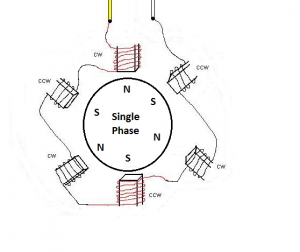
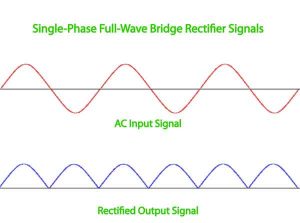
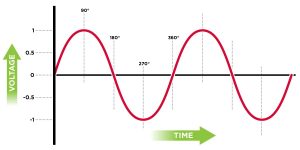
3 PHASE:
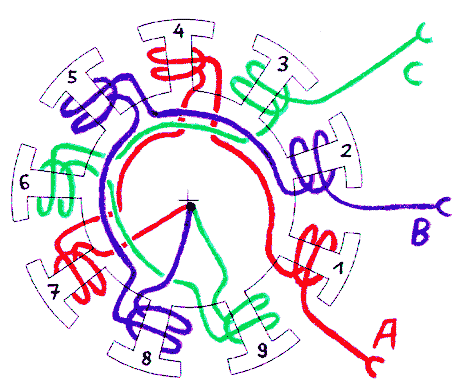
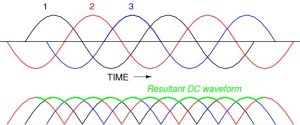
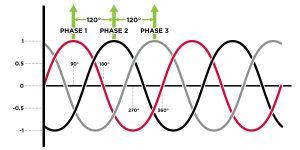
There are basically two ways to wire a 3 phase alternator, star ( or Wye) and Delta. With Delta you get lower voltage but more amps. In star you get higher voltage but less amps. You can calculate these by using the square root of 3 ( or 1.732 ). Each coil set is a “phase” of the alternator so when you measure voltage,ohms or current to test one phase of the alternator you would measure the “phase”. Once you know what the output will be from one phase you can calculate the “line” output of either delta or star. The line voltage would be measured from any 2 of the 3 outputs. If one phase measured 22 volts in your test and 10 amps then the star configuration would produce 38 volts and 10 amps ( 22 x 1.732 ). The amps remain the same as the phase measurement because the star is basically series’d to another phase. In Delta you would get 22 volts at 17.32 amps (10 amps x 1.73 ). If you calculate this out 22 volts x 17.32 = 381 watts and 38 x 10 = 380 watts… so what is the advantage? Typically the resistance in Delta is 1/3 the resistance of star. The advantage of star is the higher voltage at lower rpm. Where the Delta would require 1.5 times the rpm to start charging.
Some Basic factoids about 3 phase…. Most of the electric power in the world is 3 phase. The concept was originally conceived by Nikola Tesla and was proven that 3 phase was far superior to single phase power. 3 phase power is typically 150% more efficient than single phase in the same power range. In a single phase unit the power falls to zero three times during each cycle, in 3 phase it never drops to zero. The power delivered to the load is the same at any instant. Also, in 3 phase the conductors need only be 75% the size of conductors for single phase for the same power output.
Calculating 3 Phase Charging Output
Here is some info which may help clear up any confusion with 3 phase wattage ratings.
The Lucas stator 47244 was rated at 14 amp in the 1980 workshop manual. To find wattage we use ohms law (volts x amps = watts) 13V x 14 amp = 182 watts
Going the rough math we get 180 watts, which is what the box labels says for the reproduction stators.
To find 3 phase we need to measure the output between 2 of the 3 leads. We got 8.7 amps @ 13.5 volts 5000 rpm. Now using the factor for Star or Wye wiring of 1.732
8.7 x 1.732 = 15.05 amp now ohms law 15 x 13.5 = 202.5 watts This is what we rate the charging system at
A 12 volt battery is usually charged at 13.5 volts. When testing charging it is usually done at 6000 rpm. So if this test were done at 5000 instead of 6000 rpm you might get a different answer:
13V x 15A = 195
13.5V x 15A = 203
13V x 14A = 182
14V x 15A = 210
This is why there seems to be a few different wattage ratings on the internet.
Really the wattage is the same as a single phase alternator. The difference being in how it is wound and its output waves.
Single phase: power falls to (0) 3 times during a complete revolution. In a battery-less system you don’t really notice this at higher engine speeds. Or if you have a solid state regulator containing capacitors which help level out the output. If you run a single phase with no battery you will see this at idle what I am describing with a pulsing head light bulb.
Three phase: power never drops below zero = constant output. The phases are wire 120 degrees out of phase with each other and more efficient with no increase in size. There is also a reduction in heat which means the stator windings are under less strain so last longer. Note that current 3 phase regulators require a battery in the system to function properly.
